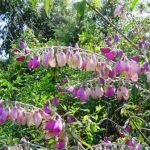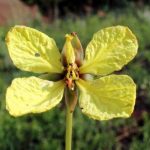TREE LIFE
February 2004
WHILE THE CURRENT FUEL CRISIS PERSISTS IT IS IMPORTANT TO CONFIRM WITH ANY OF THE COMMITTEE MEMBERS THAT THE SCHEDULED OUTINGS AND WALKS CAN ACTUALLY TAKE PLACE
MASHONALAND CALENDAR
Tuesday 3rd February. Botanic Garden Walk. Meet in the car park at 4.45 for 5 p.m. The topic will be the families Verbenaceae/Labiatae which contain Clerodendrum, Holmskioldia, Vitex, Tetradenia and more.
Sunday 15th February. Dombashawa calls us back, and at this time of the year it should be fantastic.
Saturday 28th February. Mark’s walk is at Cleveland Dam at 2.30 pm. The turnoff on the left is just after Daniko on the Mutare Road. Meet in the car park. Once again this time of year is very good for all things botanical.
Tuesday 2nd March. Botanic Garden Walk. Meet Tom in the car park at 4.45 for 5 pm.
MATABELELAND CALENDAR
Nothing has been arranged for February
OBITUARY LYNDSAY JOHN MULLIN (March 27th, 1932 – December 9th, 2003)
Lyndsay (“Lyn”) Mullin was born in 1932 in Masvingo, then known as Fort Victoria. He was the eldest of 10 children. He attended St George’s College, Harare from 1942 to 1948 and obtained a “matric exemption”. A matric exemption was then the entry qualification for South African universities, as there was no university in this country. Unfortunately, the family finances meant it was impossible for Lyn to go to university.
In 1950, Lyn, together with Richard Seward, joined a diploma course in forestry at the Southern Rhodesia School of Forestry. Lyn became the top student of the class and graduated in 1952 with a First Class diploma.
Lyn’s first posting was to Mtao Forest near Mvuma; later (1955-56) he was involved in a survey of the plantation area of Erin Forest Reserve near Juliasdale.
During 1956 and 1957 he undertook two 6 month assignments to the Kariba Basin in order to investigate methods of bush clearing in areas designated for commercial fishing. The 1956 assignment enabled a major collection of herbarium specimens of woody plants to be made from the Kariba township area.
After a period at Stapleford, Lyn was transferred to the John Meikle Forest Research Centre at Penhalonga where he rose to become the Officer in Charge from 1969 to 1975. He then moved to the Forest Research Centre in Harare, initially as part of the Research team and subsequently the leader and finally becoming the Divisional Manager.
During his 30 years in research, he published no fewer than 50 scientific and technical papers, in the process contributing enormously to forestry research in this country.
Lyn remained a bachelor for many years owing to his role as effective head of the family. In August 1980, at the age of 48, he married Anne, to whom he was happily married for 23 years.
After his retirement from the Forestry Commission in 1989, Lyn worked for Hunyani Timbers as General Manager (Estates) and subsequently, after 1992, became a freelance forestry consultant, a role he continued right up to his death at age 71.
The publication of Historic Trees of Zimbabwe marked the culmination of a 30 year project, which had earlier involved two other foresters, Dick Barrett and Lisle Orpen, to whom the work is dedicated. This work was a massive exercise and involved many difficulties (not the least of which was arranging the finance). Fortunately, the book had just appeared before he died and Lyn was able to see and handle the results of his efforts.
Lyn joined the Tree Society in 1993 and a glance at Tree Life since that year shows the impact Lyn had in providing numerous articles; effectively becoming a technical editor. Of major importance were his articles on baobabs and the long-running “In Retrospect” series in which old articles from Tree Life were re-published, often with illuminating comments from Lyn himself.
Lyn came on to the Committee in May 1999 and became Deputy Chairman in May 2001. During the last 4 years his activities within the Society had steadily increased. We all found that his quiet, methodical approach and exact knowledge, his sound advice and tact, meant that his advice was sought by us and our many correspondents all on numerous occasions.
In addition to native trees, his long forestry experience meant that he was an expert on introduced trees, which is an area of great interest to me, but perhaps somewhat neglected by the Society in the past. I particularly remember the fascinating walk he led at the Forestry Research Centre in August 1995 on the subject of the genus Eucalyptus. Lyn had produced a paper on the gums of Harare. I remember being amazed at the large numbers of species involved and their botanical complexity. Up to then, I had had rather a negative image of gums.
In subsequent years, we were lucky to experience further walks and slide shows from Lyn on gums and also on exotic conifers which opened up further new worlds. I have never forgotten the December 2002 Christmas Social at Ewanrigg where both Lyn and Tom Muller were in very fine form naming and discussing the exotic trees seen there.
His last work, which we hope to publish posthumously, is a compilation of vernacular plant names. This work was completed at the end of November.
Despite an operation in September, Lyn continued to work and remained active and highly productive until the very last days of his life. He will be sorely missed by us all.
Members of the Tree Society offer our sincere condolences to Anne and her family.
I am most grateful to Richard Seward for allowing me to draw freely from the eulogy which he presented at Lyn’s funeral and to Anne Mullin for further information.
-Mark Hyde
TREE SOCIETY CHRISTMAS SOCIAL: 7TH DECEMBER 2003
I must confess to a bit of nervousness before this year’s Christmas Social. Firstly, it was to be at Val D’Or near Ruwa and Bill Clarke, the owner, would be away on the day in the Zambezi Valley. Although I had been given detailed instructions (and keys) which involved getting through two gates and disabling the house alarm, I still wondered as to whether I would be able to manage all that or would the Tree Society members end up camping in the garden? The second concern was that I tend to rely on Maureen to organise Tree Society do’s and she was not there – travelling on the first leg of her trip to New Zealand.
In the end I needn’t have worried. We managed to get into the house and received some excellent support from Bill’s staff.

Monadenium lugardiae. Photo: J. Varden. Source: Flora of Zimbabwe
16 members attended. After a short walk to look at plants, the centerpiece of which was the Monadenium lugardiae on a small rocky kopje, we returned to the garden. The group then divided itself into two teams and we had a quiz. This was a general knowledge quiz, the questions for which had been set by Adele and Rob. This proved to be great fun, with much humour and enjoyment. Many witty suggestions were made and silly answers proposed. Some questions which I thought were very difficult were answered (what is a Wardian Case?) while easier ones (what flowers did George Russell develop?) were not. Like all quizzes, I suppose it just depends on what one happens to know.
After that we had a long, leisurely lunch and then the party headed home. This was the last Tree Society event of 2003 and was an extremely pleasant ending to a year which has not been easy for the Society.
Thanks must go in particular to various people who were not even there. Firstly to Bill and Fiona for lending us their beautiful home for the day. And, secondly to Adele Hamilton Ritchie and Rob Burrett for drawing up the quiz, which gave us all such amusement and enjoyment.
Just one final request – can we have another quiz next year?
-Mark Hyde
BUSHMAN’S POINT – LAKE CHIVERO
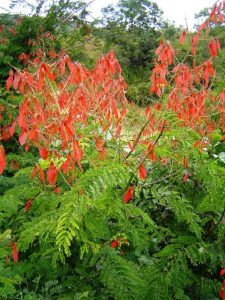
Pterolobium stellatum. Photo: Bart Wursten. Source: Flora of Zimbabwe
-October- heat, thirst, suicide month, no shade! Well this one was a turn around, for the sudden cold snap had us all out in wind cheaters and jeans, and still not quite warm. Many trees were still leafless when we arrived at Bushman’s Point, and the first to catch our attention were some heavily bossed stems, almost tree-trunk size, of the prickly scrambler, Pterolobium stellatum, a nearby specimen still holding the red-winged seed (six of which germinated for me in four days!). On the ground, very large, obovate, and still slightly velvety leaves identified Bridelia mollis, whilst smaller reddish leaflets took us to Pterocarpus rotundifolius, its flaking bark so different from Pterocarpus angolensis, which we later saw on the rocks near the paintings. Then more intriguing stems the unmistakeable, squared fluting of Grewia flavescens, usually more of a scrambly bush, as we were to find as we went up the kopje. And nearby for useful comparison, was Grewia monticola, a graceful small tree with rounded stems and white-backed leaves, both of which bear berries which attract birds.
A large Brachystegia spiciformis offered welcome shade, but it was up the kopje we go, and here we met up with Euclea natalensis, with its distinctively dirty look, and dark hairy leaves, in fruit, but far from ripe. Diospyros lycioides were plentiful, the fruit long gone to the monkeys and Louries (I believe the ornithologists have re-named these!) A little higher up, we found many lovely specimens of Diospyros nummularia (which we had been calling D. natalensis) another tree which provides food for birds and squirrels. Strychnos potatorum, which typically grows along riverbanks or amongst granite rocks, still held ageing yellow green leaves, but no seed to be seen. A leafless Erythrina puzzled for a moment, but the reddish trunk with its spiraled pattern of cracks and thorn scars, and a dry leaf on the ground, with the very broad terminal leaflet overlapping the smaller laterals (a useful M.C-P. tip) told us Erythrina latissima.
Pappea capensis was coppicing from the ground, the new shoots bearing light green serrated leaves, overshadowed by Maytenus undata, with dark trunk and dark green serrated leaves we did not need to look for the gland tips to the serrations to name this tree, which had me looking for signs of dassies, which browse on it when short of other foods. Then another normally riverine tree but surprisingly often seen amongst these big granite kopjes, was a Celtis africana, with nearby, the Rock Rhus R. leptodictya, a small tree, gracefully drooping its trifoliolate fowl’s footprint leaves. Commiphora africana without leaves was nonetheless identifiable from its poke-your-finger-in-cooling toffee wrinkles where trunks branch off. Magically, Dombeya rotundifolia scattered dry flower confetti over the kopjes head, and Tricalysia niamniamensis, frequently to be found in these sites, stood by.
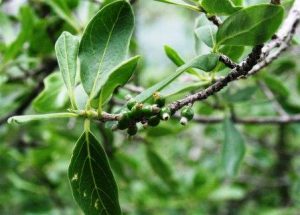
Tricalysia niamniamensis. Photo: Mark Hyde. Source: Flora of Zimbabwe
On our way down this kopje, we met up with a large Erythrina abyssinica, Ximenia caffra, its fruit still too sour to refresh, Brachylaena rotundata with it’s white-backed leaves, and Vangueria infausta with smooth grey bark and round, immature fruit. In the afternoon we would see Vangueriopsis lanciflora in bloom, the corolla lobes pointing forward before they separated to curl backwards- no fruit yet, but when we do see them, easily identified as they are lopsided.
Before turning to the Bushman Rock itself, we stopped to wonder at the small bay completely covered in the water weeds – Aeschornia, Hydrocotyle ranunculoides, and Myriophylum aquaticum, Parrot’s Feather. Does anything eat them? Near a large Ficus burkei (thonningii) and a small Ficus abutilifolia, we met with Gymnosporia(Maytenus) senegalensis festooned with the alien Passiflora subpeltatum, mixed up with the Wild Gooseberry, Withamia somniphora and wondered how good a sleeping draught it would make. Then another easy one leaves in whorls of three, and crush the leaves for the unmistakable Clerodendrum smell, and yes, there was Clerodendrum glabrum, which can be striking when in flower, if somewhat overpoweringly scented. Mistroxylon (Cassine) aethiopicum, Rhus longipes, and Vitex payos clustered along the rocky path, overshadowed by tall Burkea africana which we had seen in full bloom as we drove through the park. Faurea saligna looking like a delicate gum tree, and which I tend to associate with mineralized, rocky soils, and behind it Tetradenia riparia, added to the grace of the scene, whilst Ficus sur, Ziziphus mucronata, on the waterside of the path, contrasted a tall Pterocarpus angolensis on the topside. Another alien invader, Senna didymobotrya was flourishing. But hurry now, Rob Burrett was being persuaded to talk to us about the rock paintings, which really are good, and which so fascinate everybody. Rob told us that new dating techniques now suggest ages of between 10,000 and 16,000 years for some of the paintings, so there is almost no way that we can make more than passing guesses as to the meaning or point of these widely scattered wonders of the ancient world. Do they depict spiritual experiences, with men dancing themselves into hallucinatory trances, are those formless blobs on sticks meant to represent sources of power or mana, are they associated with foods? There can be no definite answer, but the paintings are amazing, beautiful, and greatly to be treasured!
So it was a horrible shock to find, just round the corner, that schoolboys had scribbled graffiti on other rocks, a matter to be taken up with a certain school in Harare.
A much needed R & R break followed, beadily watched by monkeys a lactating mother escaping with my packet of Cremora, clever girl, retrieved by Mark. The warning notices are there, so it was carelessness on my part! Then with renewed enthusiasm, we headed for another rock outcrop, through a typical sandveld vlei, fringed with Terminalia sericea , and islands of Syzygium guineense, Combretum collinum, Rhus tenuinervis and Acacia polyacantha which had survived veld fires, and clumps of Syzygium huillense and Combretum platyphyllum, with red-winged fruit, at ground level – but no Pygmaeothamnus that we had seen on our way in. We found the rocks almost overgrown with Ficus burkei, and, what is this? Ficus cordata ssp. salicifolia. Fresh-foliaged Combretum erythrophyllum, more Erythrina abyssinica, and Commiphora mollis surrounded the base, and, on our way back, Euclea crispa and Lannea edulis at our feet, with a small Acacia sieberiana to give me pleasure.
After a last stop to look at some more Bushman paintings, it was homeward bound for most of us, with glimpses of Eland & Zebra, Wildebeest and Impala, and Ostriches (some lucky folk had seen the Rhino in the morning) to round off a happy, cool day. My special thanks to Mark for the lift, and to all for making it such a good outing.
-Ann Bianchi.
BOTANIC GARDEN WALK: 2 DECEMBER, 2003
Tom’s subject today was the family Flacourtiaceae. The origin of the name Flacourtia (the genus, and hence the family) is from Etienne de Flacourt, 1607-1660, who was the General Director of the French East India Company and Governor of Madagascar).
The family has 20 taxa in Zimbabwe, all of which are trees and shrubs. In my view, it is a diverse family in which it is not easy to see a common thread – and this is borne out by the number of “usually”s in the following list of features in the family.
Leaves are arranged alternately and are always simple; usually they are also toothed. Stipules are usually present but tend to fall off quickly. The flowers can be either bisexual or unisexual and usually have numerous stamens. The ovary is usually superior, but may be semi-inferior. The fruit is usually a soft berry but can be hard and dry – as in Kiggelaria which has a capsule.
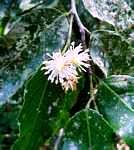
Rawsonia lucida. Photo: Bart Wursten. Source: Flora of Zimbabwe
Rawsonia lucida occurs as an understorey shrub of evergreen forest, for example in the Vumba. Its leaves are stiff and have a spiny margin. This is the species which in leaf superficially resembles Drypetes natalensis but Rawsonia has a symmetric leaf base.
Oncoba spinosa is now quite well known to us from Harare gardens. This is the fried-egg-flower with its large white petals surrounding the yellow central stamens. In the wild it occurs by lowveld rivers. It has quite large spherical fruit on which one sees the persistent style. Tom mentioned that the leaf of this species is serrate all the way round whereas in other species of Flacourtiaceae the serrations tend to be only around part of the margin. Like Flacourtia, this species tends to have red petioles.
Homalium abdessammadii is planted in the Gardens near the car park and we tend to see it quite often, but in fact it is one of Zimbabwe’s rarest trees and may even be extinct. It occurs by the edge of the Zambezi River above the Victoria Falls.
Homalium dentatum, like Bivinia, occurs in the ecotone between woodland and evergreen gullies. It occurs in the high rainfall outliers like Nyoni Hills and Bikita and is quite a rare species. Its growth habit is, also like Bivinia, straight up, but its branches ascend slightly and are not in a horizontal plane, as are those of Bivinia.
We rarely see any of the three species of Scolopia, namely: S. mundii, S. stolzii and S. zeyheri. The latter (zeyheri) is a tree of dry rain forest with rough bark and spines. (We of course have also seen it on a termite mound in Monovale). S. stolzii occurs in medium altitude and lower altitude rain forest in the lower Vumba towards the Burma Valley. It bears small flowers on older wood. One important feature is that the young leaves are bright red like the msasa and Tom reported that this is the way to find it.
Bivinia jalbertii is a rare tree in its native habitats, but as with Oncoba, we often see it in peoples’ gardens in Harare, where it makes a very handsome garden plant with its erect trunk, horizontal branches, delicate leaves and flowers and its cobwebby fruit.
Flacourtia indica is a well-known species to us, which we often see on our walks around Harare. Its fruits, which may be as much as 2 cm in diameter and are purple when ripe, make good eating in the bush. The leaves are soft and the branches are occasionally spiny.
Dovyalis caffra is the kei-apple. It is rarely seen in the wild but is apparently a truly indigenous species. Most often, we see it in cultivation. It is an exceptionally spiny species – both in the size and the number of spines.
Dovyalis hispidula is an exceptionally spiny species. It is a shrub which grows in the flood-plains of the Sabi River. The leaves are glossy and the fruit are edible and yellow.
Dovyalis lucida is a forest species, occurring in high altitude rain forest. Its leaves are, as the name suggests, exceptionally glossy.
Dovyalis zeyheri is a common species around Harare. To find this, we went over to a wild fringe of the Gardens close to St George’s College. The species is spiny, but not as spiny as D. hispidula, the leaves are usually very glossy, the bark is rough and the tree usually suckers freely. A further interesting feature is that male and female flowers occur on separate trees.
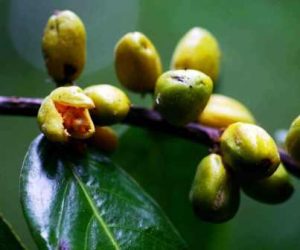
Casearia battiscombei. Photo: Bart Wursten. Source: Flora of Zimbabwe
Casearia battiscombei is a forest species of Chirinda Forest, Cecil Kop and of course the Vumba. It has serrate, alternate leaves which, unlike any other Zimbabwean species of Flacourtiaceae, have translucent gland dots and streaks in the leaves.
We did not see every Zimbabwean species of the family but we certainly saw the majority and it enabled us to revise our knowledge and get an improved understanding of the family. This is why these walks are so interesting and important to the Society, especially in these days of limited travel opportunities.
Once again, our very great thanks go to Tom.
-Mark Hyde
VISIT TO PLEASANT VALLEY, ARCTURUS 16 NOVEMBER 2003
Seventeen people participated in an outing to Kevin Fallon’s farm at the head of Pleasant Valley, just to the South of the Mutoko Road. The valley is well named indeed, a floor of flat, fertile farmland flanked by low, miombo-clad hills, with a well-treed stream and an irrigation canal running through it. Meg Coates-Palgrave led the walk and quickly got us organised, putting leaves under our tongues, smelling crushed leaves, and marvelling at the ease with which trees can be identified; “every tree has its label”.
As we gathered in the garden before setting off, we were shown a large, dead msasa (Brachystegia spiciformis) that had succumbed to the honey fungus, Armillaria mella, which is apparently causing havoc among the trees of Harare at present. It invades the base of the trunk from the soil, forming a dense mat under the bark, which starts to lift. The effect is to ring-bark the tree, resulting in its rapid death. Removing the bark reveals a mass of fungal threads with a very sweet smell; hence the common name. The fungus is not specific to any tree species and has caused particularly heavy mortality amongst fever trees (Acacia xanthophloea) in private gardens and the Botanic Gardens this year.
The first tree to catch our attention on the walk, just outside the garden gate, was Celtis africana, the so-called white stinkwood. Meg told us that in Johannesburg, where this tree is a very popular and successful ornamental, it is hybridising with its introduced cousins, C. australis and C. sinensis, to the extent that it is becoming difficult to distinguish which tree is which. She takes this as evidence that the three trees are one species, originating in Gondwanaland, but we wisely sidestepped a debate on the defining characters and significance of species and subspecies, which usually fails to reach a conclusion.
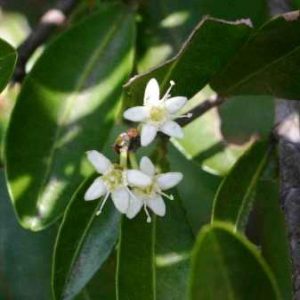
Erythroxylum emarginatum. Photo: Bart Wursten. Source: Flora of Zimbabwe
The first part of our walk took us along a track that separated a neglected eucalypt plantation from the surrounding indigenous woodland. The woodland was not particularly attractive and was heavily invaded by jacarandas, but it contained a good number of species that we were encouraged to examine. The species whose leaf we had to taste was Erythroxylum emarginatum, the African coca-tree. It is related to E. coca, the South American source of cocaine, but, as we discovered, has no psychogenic properties itself. It is a shrub or small tree with relatively small, simple leaves. Its labels are a notch in the leaf apex and laterally flattened branchlets that resemble lizard legs because they are covered with small scales, the persistent stipules. Meg did not ask us to sample Catha edulis, bushman’s tea, which can also have psychogenic effects. It is a shrub or small tree with long, narrow, pendulous leaves, rather like a eucalypt, but with toothed margins. Young leaves and stems are known as “khat” in Ethiopia and the Middle East and are chewed for their narcotic effect. The only area in Southern Africa where the tree is used for this purpose is around Kingwilliamstown, in the Eastern Cape; presumably the Zimbabwe trees do not have this property, otherwise we would all be chewing them to forget our problems. The tree whose leaves we had to crush and smell was Rhus longipes, a very common shrub that can grow into a sizeable tree in some situations and has trifoliolate leaves with oval leaflets with entire margins. A characteristic of the genus is the release of a smell of green apples when the leaves are crushed. The smell originates from a resin that is contained in minute channels that can be seen with the naked eye at the base of the petiole when the leaf is removed.
We emerged from the woodland into a grove of very well established trees surrounding the irrigation canal. Prominent among them were some enormous specimens of Ficus sycomorus, the sycomore fig. Several very large Erythrina in the grove gave rise to debate as to the specific identity. One had a thickly ridged, corky bark, another a much smoother, spiny bark, and Meg had no labels for them. The final consensus was that they were both E. abysinnica, rather than E. latissima, because the leaflets did not overlap. Whatever their identity, they were magnificent specimens, and were accompanied by some equally magnificent Celtis africana.
The group began to fragment as we reached the woodland fringing the arable land; the heat, lunch dates or the races. We identified a variety of Acacia species; flat-topped A. sieberiana, nearing the end of their flowering season, upright A. polyacantha, just beginning theirs, and A. karroo, which Meg identifies by the small number of pinnae pairs (not more than six) and the spaces between the leaflets, as well as the straight spines. A small party crossed to the riverine woodland on the other side of a field of onions but was frustrated by a thick tangle of Lantana camara and other shrubs from reaching the stream itself. I turned for home, but I found a way into the stream bed and was richly rewarded by the peaceful atmosphere of the enormous trees standing on a carpet of dried leaves. The largest tree I recognised was a Mimusops zeyheri, the red milkwood, which has long, elliptic, shiny green leaves, in which the midrib is slightly raised and, as the name implies, there is a white latex. Other prominent species were Rauvolfia caffra, which also has a white latex but has much longer leaves, and an Ekebergia species that puzzled us. We finally agreed that it was E. capensis on account of its pointed leaflets; E. benguelensis, which we found on the hillside, has round-tipped leaflets. I picked up wafts of a very sweet scent in the woodland that I could not associate with any particular plant; I wonder where it came from.
We regrouped for lunch in Kevin’s garden. After lunch, some of the ladies went for a drive with Terry to the dam, to look for birds. Some relaxed in the garden. Three of us rambled for a while on the hillside behind the house. It was covered with Brachystegia boehmii regrowth and heavily invaded by jacarandas, but we found several species that we had not seen lower down, including Acacia amythethophylla, which at first sight resembles the jacaranda because of its spreading leaves, but has round-tipped leaflets, not pointed ones, as well as short spines. Other interesting trees were young Combretum molle bearing soft, pale green, spherical galls, and unusually large Combretum platyphyllum with slender, creeper-like branches up to 1 m long bearing tufty red flowers; they are usually much smaller and lower.
It was a very pleasant outing in a lovely setting. We would like to thank Kevin for his hospitality and look forward, hopefully, to another visit when we can explore the riverine woodland more thoroughly.
-John A Lawrence
HISTORIC TREES OF ZIMBABWE by Lyn Mullin
Lyn Mullin’s long-awaited book on historic trees is now out and I strongly recommend that members of the Tree Society should get a copy. In the book, a number of trees of special interest are covered, either because they are historically important or because they are special in some other way for example they are the broadest, tallest or oldest. For each tree, there is a photograph and a detailed account of their significance.
The book has a great deal of local interest. My reaction to it was a desire to try and see these trees myself and details including 6 figure grid references are provided for each one. Perhaps we should devote a Saturday afternoon walk to seeing the Harare trees.
Sumptuously produced, the book is available in three forms: soft back, hard back and leather bound. Only the soft back is available in the shops, but it, and the hard back and leather bound versions, can be obtained much more cheaply direct from Anne Mullin at the following prices: soft: $90,000; hard: 150,000; leather: $200,000. Anne can be contacted on 747169, but please note that she is away at the moment and won’t be back until mid-February.
-Mark Hyde
MARK HYDE CHAIRMAN


